Roma antica foro romano colosseo altare della patria circo massimo roma virtuale 3d lazio
monumenti-eng
inglese
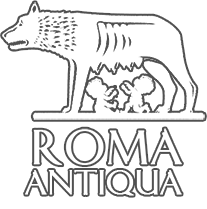


Monuments
Coliseum Flavian Amphitheatre
The construction of the Coliseum, the monument that best represents Rome, began under the emperor Vespasian of the Flavian dynasty in 72 AD and was completed in 80 AD under his son Titus. The structure replaced the small artificial lake near Nero emperor ‘s Domus Aurea.
It is 50 mt high, made from travertine stone, very used in ancient Rome, and comprises 4 orders of superimposed arcades.
The original arena was about 76 per 46 mt and it’s estimated could hold up to 60000 people. Two galleries were provided where the minor axe ends to accomodate the imperial family, the major senators and ecclesiastic class.
The Coliseum, whose official name is Flavian Amphitheatre was used for gladiatorial contests and hunting games. The building as it is now, is the result of devastating earthquakes (442 ad, 508 ad. and 1348 ) that made collapse part of its external walls. It was later restored thanks to the projects committed by Popes in the centuries.
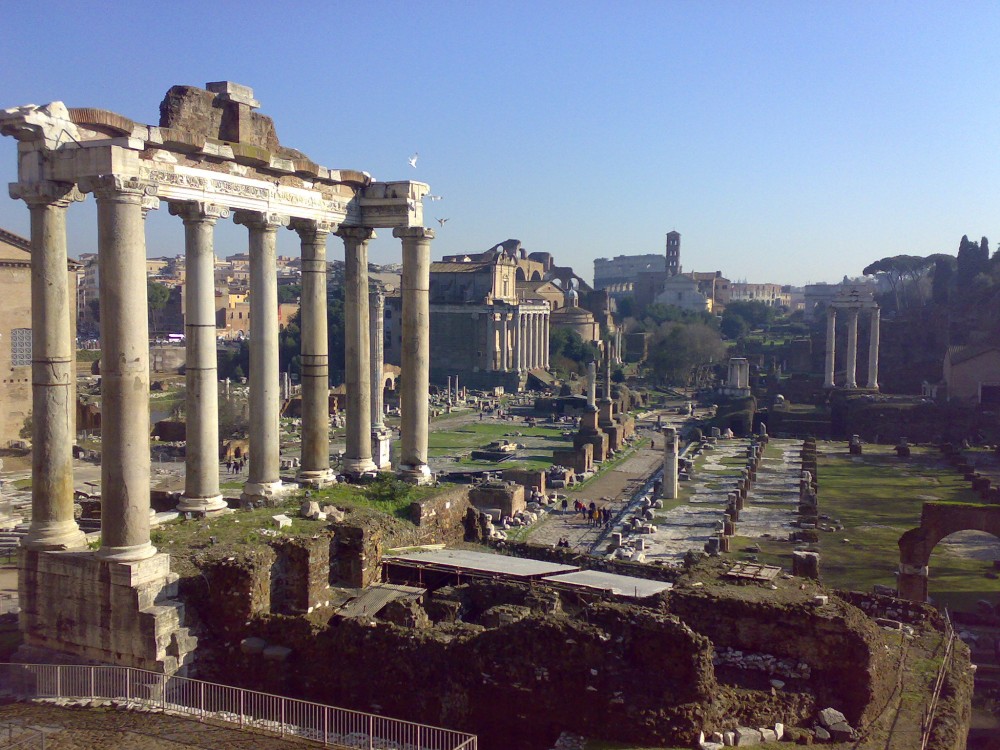 Located between Palatine, Capitol and Quirinal Hills, originally the Roman Forum was the center of commercial, religious and political life. The whole area has been changing since 200 bc with the edification of tribunals and buildings for public administration and it’s final setting is due to Cesar and Augustus. Archaeological excavations around the XIX century restored Forum remains digged and abandoned for centuries. Many monuments can still been seen in the Roman Forum: the Senate, The Aemilia Basilica, The Saturn Temple, The Vestae Temple, The Caesar Temple, The Complex of Vestal Virgins, dating back the period before Christ, whereas the Arch of Titus, Massenzio Basilica, The column of Foca, dating back the period after Christ.
Located between Palatine, Capitol and Quirinal Hills, originally the Roman Forum was the center of commercial, religious and political life. The whole area has been changing since 200 bc with the edification of tribunals and buildings for public administration and it’s final setting is due to Cesar and Augustus. Archaeological excavations around the XIX century restored Forum remains digged and abandoned for centuries. Many monuments can still been seen in the Roman Forum: the Senate, The Aemilia Basilica, The Saturn Temple, The Vestae Temple, The Caesar Temple, The Complex of Vestal Virgins, dating back the period before Christ, whereas the Arch of Titus, Massenzio Basilica, The column of Foca, dating back the period after Christ.
Also known by the name of Tulliano or Carcer Tullianum, it is Rome’s most ancient prison. Located within the Roman Forum, more precisely in the undergrounds of the church of St. Joseph of the Carpenters. The prison is related to St. Peter and St. Paul, in fact it is said that St. Peter fell going down the prison stairs, hitting his head on the wall and leaving the imprint of his head on the stone. The two saints were locked up in the dungeons but armed with an ampoule of water they were able convert and baptize the prison keepers. Today the prison is open to the public with a picturesque path on multiple levels where you can admire the archeological discoveries, the architectural structure and the paintings.
Settimio Severo’s Arch
Castore e Polluca’s Temple
Divo Giulio’s Temple
Basilica Aemilia
Vesta’s Temple
Pantheon
Located in Piazza della Rotonda, the Pantheon was a temple dedicated to pagan deities. It was built by Agrippa in I century BC, then it was modified at the beginning of II century AC and took the shape that we can still admire.The temple was a gift by the emperor Foca to Pope Bonifacio IV in 608, and was used as a Church. The big dome is 43 mts high and was one of the great architectural work by the time. It was built with less dense stones successively disposed up to the center so to reduce its weight and prevent from collapsing .The magnificence of Pantheon, where the tomb of Victor Emmanuel II and of Raphael Sanzio, great painter of the 500’s, are located, is due to the valuable polychrome marbles and granite columns indoor, more than 14 mts high.
Vittoriano
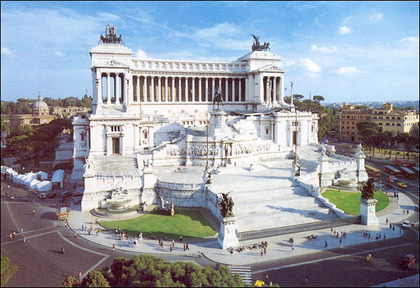 The Vittoriano was built in 1878 after a royal ordinance in honour of the first king of Italy (1861), Vittorio Emanuele II, who died not long before, that was considered a hero of unified Italy.The classical style echoes the greatness of the ancient tradition and its dimension wants to celebrate the majesty of Rome that, after long time, had return to the role of Capital of Italy. To build this gigantic monument many other medieval buildings were tore down. The Victoriano stands on Piazza Venezia and on top of its great steps it holds the tomb of the unknown soldier buried in the Altar of the Fatherland On the upper side of the monument, each pronaos holds two majestic and awful winged Victories riding on two bronze chariots which recall the architecture of triumphal arches.
The Vittoriano was built in 1878 after a royal ordinance in honour of the first king of Italy (1861), Vittorio Emanuele II, who died not long before, that was considered a hero of unified Italy.The classical style echoes the greatness of the ancient tradition and its dimension wants to celebrate the majesty of Rome that, after long time, had return to the role of Capital of Italy. To build this gigantic monument many other medieval buildings were tore down. The Victoriano stands on Piazza Venezia and on top of its great steps it holds the tomb of the unknown soldier buried in the Altar of the Fatherland On the upper side of the monument, each pronaos holds two majestic and awful winged Victories riding on two bronze chariots which recall the architecture of triumphal arches.
Castel Sant’Angelo
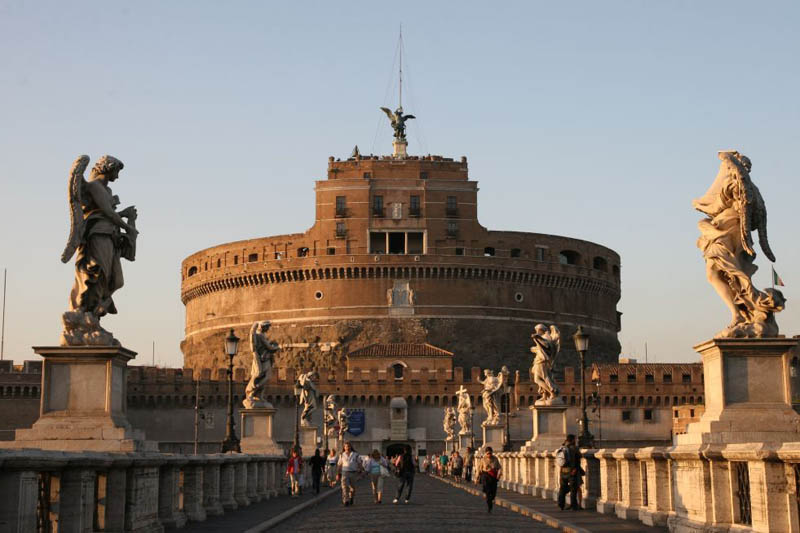 Its original structure was initially commissioned by the Emperor Hadrian as a mausoleo for himself. Pons Aelius , best known as St Angel Bridge, was built in 135 AC to connect the area of Campo Marzio to the tomb of the Emperor Aelius Hadrian. It takes its name after the great statue of the angel towering over the terrace to recall when the Archangel Michael appared to the Pope Saint Gregory Magno, in VI century, announcing the end of the plague The Bell of the Mercy, located next to the angel statue was originally rung to inform population of capital executions. The Vatican Corridor, also known as ‘Passetto’, was built at the end of XIII century . The passageway connects the Castle to the Vatican Palace, a lifted escape route that allowed the Pope to escape in case of siege .
Its original structure was initially commissioned by the Emperor Hadrian as a mausoleo for himself. Pons Aelius , best known as St Angel Bridge, was built in 135 AC to connect the area of Campo Marzio to the tomb of the Emperor Aelius Hadrian. It takes its name after the great statue of the angel towering over the terrace to recall when the Archangel Michael appared to the Pope Saint Gregory Magno, in VI century, announcing the end of the plague The Bell of the Mercy, located next to the angel statue was originally rung to inform population of capital executions. The Vatican Corridor, also known as ‘Passetto’, was built at the end of XIII century . The passageway connects the Castle to the Vatican Palace, a lifted escape route that allowed the Pope to escape in case of siege .
The circular temple, alias Temple of Vesta in the Forum Boarium
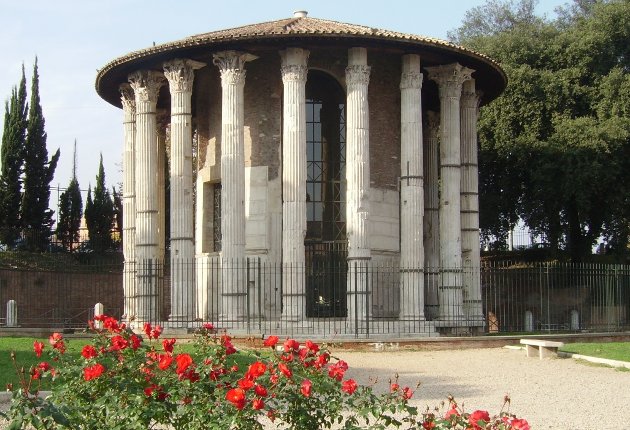 The Temple of Hercules Victor or Hercules Olearius stands in Bocca della Verità Place not far from the Temple of Portuno, inside the Forum Boarium. Due to a misunderstanding in the Renaissance, the temple is commonly referred as Temple of Vesta for its circular shape similar to the real Temple of Vesta in The Roman Forum. Dating back to 120 BC, it’s the best preserved ancient marble bulding in Rome. (The oldest was the Temple of Jupiter Stator in the Portico of Metellus dating 146 BC, today lost).
The Temple of Hercules Victor or Hercules Olearius stands in Bocca della Verità Place not far from the Temple of Portuno, inside the Forum Boarium. Due to a misunderstanding in the Renaissance, the temple is commonly referred as Temple of Vesta for its circular shape similar to the real Temple of Vesta in The Roman Forum. Dating back to 120 BC, it’s the best preserved ancient marble bulding in Rome. (The oldest was the Temple of Jupiter Stator in the Portico of Metellus dating 146 BC, today lost).
Mouth of Truth (Boarium)
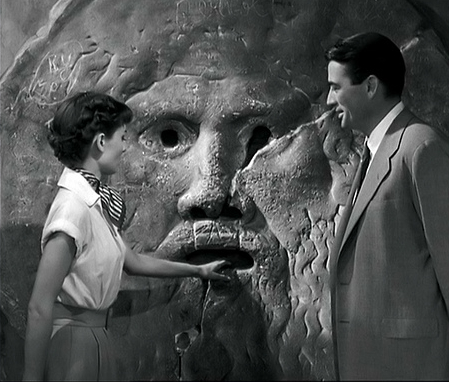 It is situated in one of the most interesting areas of Rome, the Boarium Forum one, where, there are many beauties such as the Temple of Coturno, the Temple of Hercules, or the most recent Triton Fountain, realised by Carlo Bizzaccheri on commission by Pope Clement XI, situated on the place in 1715.
It is situated in one of the most interesting areas of Rome, the Boarium Forum one, where, there are many beauties such as the Temple of Coturno, the Temple of Hercules, or the most recent Triton Fountain, realised by Carlo Bizzaccheri on commission by Pope Clement XI, situated on the place in 1715.
In this scenery you can find the church of Saint Mary in Cosmedin. A great and ancient mask was walled up there in the wall of the pronaos in 1632.
It was, probably an ancient manhole, with a diameter of 1.80 metres, it looks like a male face with a beard and eyes, nose and mouth are pierced to let water flow in the past.
Today it’s a undisputed pilgrimage of tourists, thanks to its renown, linked to popular traditions, which narrate that the Mouth of Truth could “bite” who doesn’t tell the truth, a legend exploited above all by husbands to discover the adulteries of their wives.
The tourists queue to be photographed with the hand in the Mouth of Truth, especially after 1953 when the film “Roman Holiday” showed it to the world.
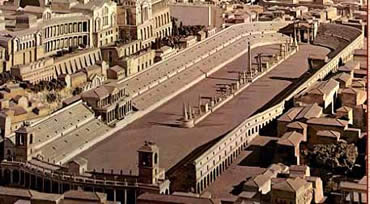 It’s 600 mts long and about 140 mts wide, the Circus Maximus was the bigger building for public events and entertainment ever. Built in the fifth century BC long the natural outline of the valley between the Aventine and the Palatine Hill, it could accommodate up to 250.000 spectators. Legend holds that the site of Circus Maximus was linked to the birth of town. It was discovered soon after the founding of Rome, and chosen as the setting for games to celebrate Conso, during which it took place the Rape of The Sabine women. As many other buildings in Rome, the Circus Maximus was burned down many times and rebuilt in Domitian -Trajan age between the first and the second century AD, and its structure remained unchanged so far. Many of the succeeding emperors, took changes to the structure The magnificent egyptian obelisks once decorating the central area, the so-called spina, were re-sited in Piazza del Popolo and Piazza Laterano. The Circus Maximus as a chariot-racing circuit fell out of favour in the sixth Century AC, when Totila king of ostrogoth held the last games..
It’s 600 mts long and about 140 mts wide, the Circus Maximus was the bigger building for public events and entertainment ever. Built in the fifth century BC long the natural outline of the valley between the Aventine and the Palatine Hill, it could accommodate up to 250.000 spectators. Legend holds that the site of Circus Maximus was linked to the birth of town. It was discovered soon after the founding of Rome, and chosen as the setting for games to celebrate Conso, during which it took place the Rape of The Sabine women. As many other buildings in Rome, the Circus Maximus was burned down many times and rebuilt in Domitian -Trajan age between the first and the second century AD, and its structure remained unchanged so far. Many of the succeeding emperors, took changes to the structure The magnificent egyptian obelisks once decorating the central area, the so-called spina, were re-sited in Piazza del Popolo and Piazza Laterano. The Circus Maximus as a chariot-racing circuit fell out of favour in the sixth Century AC, when Totila king of ostrogoth held the last games..
Baths of Caracalla
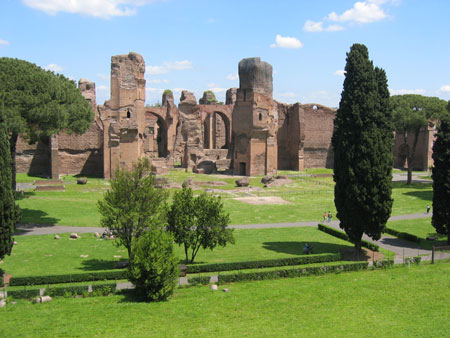 The Baths were one of the largest and best preserved thermal stucture of the roman age. Wished by Settimio Severo and inaugurated by his son Antonino Bassiano, called Caracalla in 200 AC. the Baths of Caracalla accomodated about 1600 people and provided for hot, warm and cold water. The Thermae were decorated with wonderful frescos, precious marble and statues. Gardens, pools, libraries completed one of the most important centers in ancient times. The Thermae had very short life. They were abandoned after only 300 years due to the siege of Vitige, the famous king of Goths in sixth century AD, who blocked the water flow in the acqueduct of Roman inhabitants. They so became a burial place for pilgrims that fell ill while travelling to Rome.
The Baths were one of the largest and best preserved thermal stucture of the roman age. Wished by Settimio Severo and inaugurated by his son Antonino Bassiano, called Caracalla in 200 AC. the Baths of Caracalla accomodated about 1600 people and provided for hot, warm and cold water. The Thermae were decorated with wonderful frescos, precious marble and statues. Gardens, pools, libraries completed one of the most important centers in ancient times. The Thermae had very short life. They were abandoned after only 300 years due to the siege of Vitige, the famous king of Goths in sixth century AD, who blocked the water flow in the acqueduct of Roman inhabitants. They so became a burial place for pilgrims that fell ill while travelling to Rome.
Trajan’s market
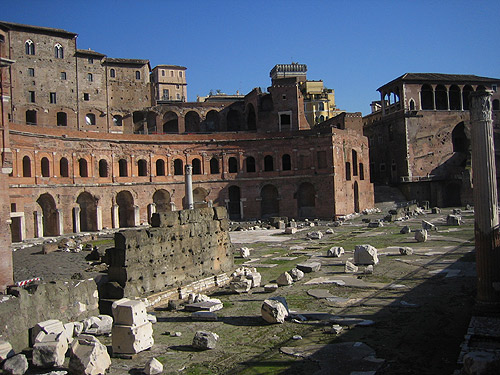 It is situated on the hillside of the Quirinal, it was built in the II century a.C., with the building technique of the “tile” (cement covered by bricks), and the available spaces obtained by cutting the flanks of the hill were exploited very well.
It is situated on the hillside of the Quirinal, it was built in the II century a.C., with the building technique of the “tile” (cement covered by bricks), and the available spaces obtained by cutting the flanks of the hill were exploited very well.
It was planned by Trajan (although it is thought the works started during the Domitian’s reign because of the recent founds) for a plan of a supplying system in Rome, it was improved through the building of Trajan’s harbour too.
It seemed like a big “shopping centre”, with rooms and open passageways, but the monument was more than a "polyfunctional centre” where many administrative activities took place; you can suppose it thanks to the presence of tidy rooms and places, many “tabernae”, a kind of restaurant of the Roman Period.
The complex was 310 m long, and 185 m large, and it comprised, the Forensic Square, the Basilica Ulpia, a court-yard- with the Trajan’s Column, two libraries, and the temple of Divine Trajan and Plotina, lately added by Hadrian.
Theatre of Marcellus
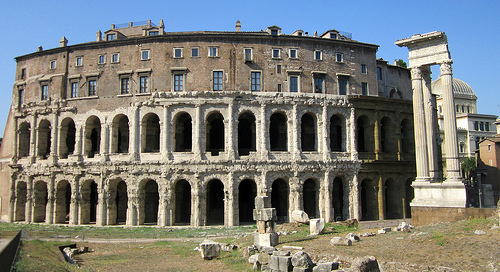 It is similar to the Colosseum but it was semicircular. It was 130 metres in diameter. It could hold 15.000 people.
It is similar to the Colosseum but it was semicircular. It was 130 metres in diameter. It could hold 15.000 people.
It was built on wish of Caesar, he expropriated and demolished the area, sacrificing the Temple of Pity and he was criticized.
The work was completed by Augustus in 11 b.C., but in 500 the original structure was modified because Baldassarre Peruzzi built a palace of wish of Savelli family. It was still there.
It’s a wonderful example of historical preservation, it is used today by great musicians for the summer show “I concerti del tempietto” (the concerts of the little temple), like the lyrical ones set at Caracalla.
Foro Italico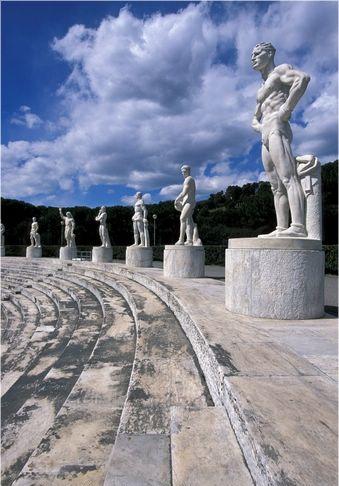
Foro Italico includes the Palazzo H (now called the Palazzo CONI), the Stadio Olimpico (with a capacity of about 100,000 people) and the Stadio dei Marmi.
It was built upon request of Mussolini and carried out during the Fascist period according to a project called Città dello Sport (City of Sport).
The Stadio dei Marmi, entirely made of Carrara marbles, shows a unique beauty: it is able to host 16,000 people and is encircled by 62 statues of athletes in different postures.
The Quirinal Palace
The Quirinal Palace was built and completed during Paolo V Pontificate by the architect Flaminio Ponzio, who projected the wing of the palace near the garden. This area includes the Honour Stairs, the Salone delle Feste and the Annunziata Chapel. After his death, Carlo Maderno completed the wing towards Via del Quirinale. The palace is located on Quirinal Hill where once took place the temples in honour of Quirino God and Health Goddess.
It has been the Papal summer residence for about three centuries, till 1870; after 1871 it became the Residence of the King of Italy. Since 1946 it is the official seat of President of the Italian Republic.
The little Temple of Bramante
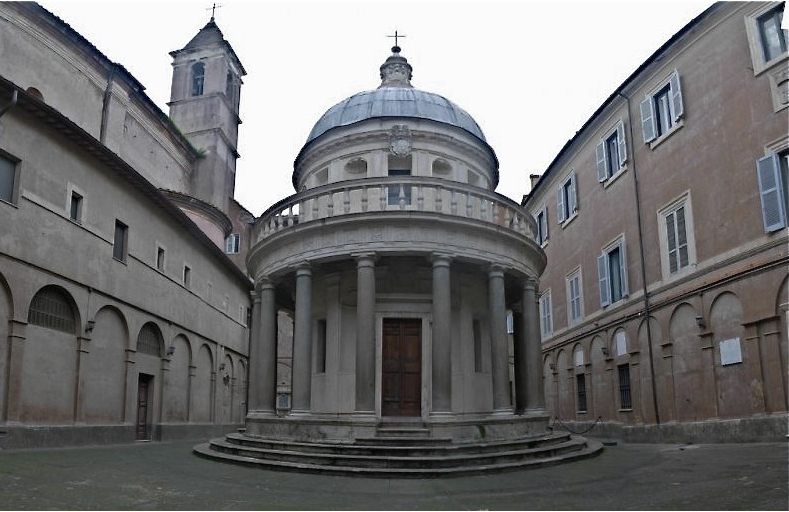 A masterpiece of Bramante, realized in 1502 on wish of the kings of Spain, to commemorate the place of execution of Saint Peter.
A masterpiece of Bramante, realized in 1502 on wish of the kings of Spain, to commemorate the place of execution of Saint Peter.
Outside it shows a colonnade, rested on a little circular flight of steps, surrounded by a balaustrade from which la cupola stood, partially modified by interventions of the XVII century.
Inside the plan is circular and it shows a statue of the apostle on the altar, realized by an anonymous artist of the Lombard school of the XVI century. Under the hall with circular plan there is a crypt, where a gravestone on the floor protects the hole left by Saint Peter’s cross.
Saint Helen’s Mausoleum
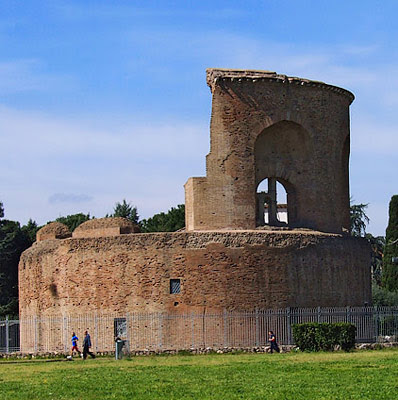 Saint Helen’s Mausoleum which today is partly collapsed, had an external diameter of 27,74 meters and a height of 25,42 meters, it was of the Constantinian period (around 320 d.c.). It is located near Via Casilina which corresponds to the III mile of the Ancient Via Labicana, in the region formerly known as “ad duas lauros” (the two laurels). It was destined to receive the remains of emperor Constantine instead of those of his mother Helen as it actually happened. Helen’s large sarcophagus of porphyry on which battle subjects are sculpted, today is located in the Vatican Museums. Saint Helen’s body was deposed during the XII century in the church of Saint Mary of Aracoeli. The mausoleum is being restored and recently it is possible to also visit the many findings of the imperial cavalry since the entire area was a large cemetery.
Saint Helen’s Mausoleum which today is partly collapsed, had an external diameter of 27,74 meters and a height of 25,42 meters, it was of the Constantinian period (around 320 d.c.). It is located near Via Casilina which corresponds to the III mile of the Ancient Via Labicana, in the region formerly known as “ad duas lauros” (the two laurels). It was destined to receive the remains of emperor Constantine instead of those of his mother Helen as it actually happened. Helen’s large sarcophagus of porphyry on which battle subjects are sculpted, today is located in the Vatican Museums. Saint Helen’s body was deposed during the XII century in the church of Saint Mary of Aracoeli. The mausoleum is being restored and recently it is possible to also visit the many findings of the imperial cavalry since the entire area was a large cemetery.
Portico of Octavia
The Portico of Octavia is one of Rome’s most striking passages, it was located at the borders of the Jewish ghetto, in the ancient area called Circus Flaminius.
In 146 a.c. Quintus Caecilius Metellus erected in this area the Temple of Queen Juno and later the Temple of Jupiter, the first in Rome to be entirely built with marble.
However the name was given by emperor Augustus, who between 33 a.c. and 27 a.c. restored the entire area thanks to the war chest from the victory on Dalmatia and dedicated the portico to his sister Octavia. The portico was 119 meters wide and 132 meters long, completely covered with marble, inside it guarded numerous works of art. It was part of the itinerary of the triumphal processions which were celebrated in occasions of victories, with the armed emperor, the army and the conquered trophies. Over time in this area many important temples were erected, each one built by victorious emperors to celebrate themselves. The archaeological excavations resulted in important historical and scientific acquisitions which brought to the identification of at least four different historical periods, the first three of Roman time and the forth of medieval time: Metellus period, Augustus period, Severus period, cemeterial period. At the end of 1800s to reclaim the area the French carried out massive demolitions but it’s the fascist period that gave end to the Portico of Octavia with the indiscriminate widening of many ancient roads.
